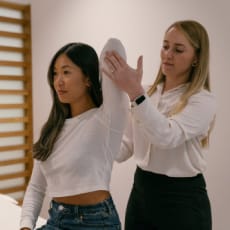The Concussion Blog – The Cervical Spine’s Role in Concussion Symptoms

Dr Theo Farley
Physiotherapist
- 21 September, 2018
- Concussion Clinic
- Neurology
- 4 min read
Welcome to this week’s blog on concussion management in the sporting context.

This week we’re going to look at the contribution of the cervical spine to concussive symptoms and consider how we can differentiate between symptoms arising from the cervical spine, the brain and the vestibular and oculomotor systems.
The primary source that I’ll use is an article by Cheever, 2016 who is an Athletic Trainer from Philadelphia:
Cheever, Kawata, Tierney; Cervical Injury Assessments for Concussion Evaluation: A Review. Journal of Athletic Training 2016;51(12):1037–1044
I suppose how you see the relevance of this weeks’ blog depends on which components you consider to make up a concussion. When I’m managing an athlete I would generally consider their injury from a brain physiology (see last weeks blog), vestibular, oculomotor and a cervical perspective. Although there isn’t definitive literature on the cervical spine in concussion, it’s involvement is relatively well accepted clinically and it is one of the symptoms on the SCAT 3, so if your athlete has neck pain they’re not clear of their ‘concussion’.
Cheever and colleagues looked at the similarities in mechanism of injury and symptoms between concussion and cervical spine injuries, the physiology of cervical spine injury and the tests available to isolate and differentiate between cervical spine injury and concussion.
We know through experience that cervical injuries in sport will normally occur through acceleration/deceleration injuries or forced and rapid rotation. This is identical to most concussions with the inclusion of direct trauma. If we’re faced clinically with an athlete that has let’s say, neck pain, headache and dizziness, we won’t be able to reliably differentiate between the two injuries. I don’t think it’s a stretch to say that some neck injuries may be misdiagnosed as minor concussions. That said it’s always best to err on the side on caution.
Physiology of cervical injury
Cervical afferents have a complex relationship with the sensory and motor nuclei of the brainstem (see image above, right). Within the cerebellum cervical somatosensory information is integrated with ocular and vestibular information for adaptive postural and oculomotor regulation. Cervical afferent also project through the dorsal column to the thalamus (part of brain that relays sensory and motor signals to the cerebral cortex) and primary somatosensory cortex for perception of head and body position. They will also contribute to anticipatory ocular and postural adjustments during functional movements.
Cervical afferents interact with the vestibular nuclei, the superior colliculi and central cervical nuclei, which are all concerned with coordinating gaze stabilisation and postural stability.
When cervical afferents interact with the superior colliculi, they produced the cervico ocular reflex and supplement the vestibular ocular reflex; responsible for gaze stabilisation, smooth pursuit and saccadic control during scanning and tracking activities such as reading an opponents movement or watching a phase of play develop. These are all areas that we looked at in our first blog that considered vestibular and oculomotor assessment.
So, on to more practical application of this story. Cervicogenic headaches are generally attributed to C1-3 dysfunction. These levels communicate with the trigeminal nerve through the spinal sensory trigeminal tract. The trigeminal nerve receives sensory information from the anterior portions of the head, the greater occipital nerve, and branches of the upper cervical roots (2).
It is this misinformation from muscle spindles, joint and pain receptors and cervical nerve roots that are thought to contribute to cervicogenic headaches, vertigo, dizziness and disorientation (1).
Assessment
The tests described in table 2. have been selected by the reviewers on the basis that they removed vestibular and visual influences and therefore isolated cervical sensory information.
The sensitivity and specificity for these tests are very high but there is no mentioned of whether they were used on concussion patients, and therefore the clinical utility in the our patient group is limited. Further more I’m not convinced that you can really remove vestibular provocation when you’re rotating the head, even slowly. Having said that, tests such as the cervical joint position error test is great tool for assessing sensorimotor control from the cervical afferent pathways which is crucial to avoiding re injury or an initial concussive injury. A 2010 study by Viano looked at head impact in relation to neck position and found that when the head was aligned with the torso the force of impact was reduced by up to 67%. You can see from this how important good neck proprioception is in injury avoidance.
The cervical flexion rotation test has excellent clinical utility in diagnosing C0/1/2 dysfunction where 50% of neck flexion and rotation occurs and 50% of the cervical spine’s proprioceptors are situated.
The head/neck differentiation test uses a spinning chair to move the body under the head and vice versa to differentiate between neck and vestibular pathology. Personally, I like the idea of this test, but there is no specificity/sensitivity data and practically I can see it getting raised eye brows from athletes!
Conclusion
Concussion is a pathomechanical event affecting multiple structures. Considering this review by Cheever I think it would be unreliable and potentially dangerous to try and unpick and differentiate between concussion and cervical spine injuries. A far better approach would be to take a holistic view of concussion management that included the cervical spine as a key driver to pathology. There is clear evidence of the contribution that the cervical afferents play in the normal functioning of the oculomotor and vestibular systems. Both are key contributors to the balance and spatial orientation abilities of the athlete. Although this article doesn’t cover treatment of the cervical spine it gives us clear ideas on where to focus our treatment. When approaching the treatment of an acutely concussed athlete it is always important to start light and build tolerance to treatment progressively.
References
1. Guskiewicz KM, Mihalik JP, Shankar V, Marshall SW, Crowell DH, Oliaro SM, Ciocca MF, Hooker DN. Measurement of head impacts in collegiate football players: relationship between head impact biomechanics and acute clinical outcome after concussion. Neurosurgery. 2007 Dec;61(6):1244-52; discussion 1252-3.
2. Piovesan EJ1, Kowacs PA, Oshinsky ML. Convergence of cervical and trigeminal sensory afferents. Curr Pain Headache Rep. 2003 Oct;7(5):377-83.
3. Viano DC, Casson IR, Pellman EJ, Bir CA, Zhang L, Sherman DC, Boitano MA. Concussion in professional football: comparison with boxing head impacts–part 10. Neurosurgery. 2005 Dec;57(6):1154-72; discussion 1154-72.

Advice
Over the last 20+ years our experts have helped more than 100,000 patients, but we don’t stop there. We also like to share our knowledge and insight to help people lead healthier lives, and here you will find our extensive library of advice on a variety of topics to help you do the same.
OUR ADVICE HUBS See all Advice Hubs

